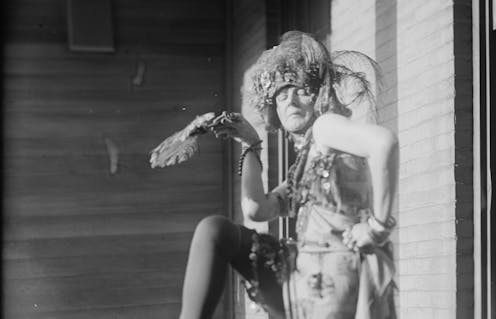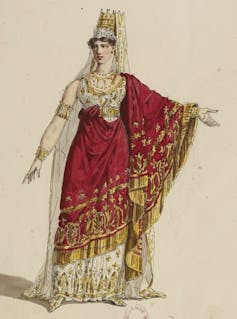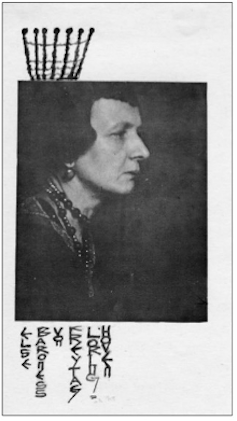
Digital archives have become powerful platforms for women artists who were excluded from official art history, allowing them to claim their rightful place posthumously.
This is evident in dedicated digital projects for early-to-mid 20th century avant-gardists like artist, writer and entrepreneur Mina Loy, antiwar activist and cabaret artist Emmy Hennings or Dada artist Elsa von Freytag-Loringhoven. The latter was better known as the Baroness or Baroness Elsa following her 1913 New York City Hall marriage to an impoverished German baron who was then residing in the United States. The Baroness has been the subject of my research.
However, amid the legitimate excitement of bringing overlooked female artists into the foreground through archival work, there are problems when digital copies of archives proliferate and aren’t critically contextualized.
‘The Living Dada’
Dada, an anti-bourgeois art movement that emerged during the First World War, challenged western institutions of art through its rabble-rousing manifestos, collages and performances.
Among Dada’s controversial, albeit less well-known practitioners, was Freytag-Loringhoven (1874-1927), a German emigree poet and performer. She was known as the “living Dada” in New York.
My research has documented Baroness Elsa’s value as an early feminist performance artist who made bold statements through her attire. She drew on the irrational to express the trauma of the era, as art historian Amelia Jones chronicles. Writer Caroline Knighton has examined how Baroness Elsa used waste products in art to subversively link art to thrift culture.
The University of Maryland’s online accessibility to Freytag-Loringhoven’s manuscripts and papers has played a pivotal role in restoring the artist’s rightful place in history.
Using digital methods, literature scholar Tanya Clement has explored Freytag-Loringhoven’s experimental poetry through the lens of “textual performance.”
Unverified images
As the Baronness’s profile has been raised through research, so have less authoritative depictions of her work. A photograph lacking proper attribution and sourcing is presented on various websites as Freytag-Loringhoven. A reverse image search reveals the photo to be from a Russian theatre performance of the play The Blue Bird (1884-1940). Other research confirms the photo actually shows Russian actress Maria Germanova.
This image also points to a deeper interplay between the Baroness and the West’s fin-de-siecle fascination with orientalism, a harmful cultural practice originating in the west in a context of imperial domination that conceptualizes the East in alluringly exotic and sensualist terms.
Seeing this image asks us to question how the Baroness was conceptualized and stereotyped within orientalist terms during her era, her relationship to this lens and how these issues manifest in current depictions of her.
Orientalist, sexist 1915 descriptors
In 1915, the New York Times’ Dec. 5 issue introduced the Baroness’s artmaking in orientalist terms. Her Polish descent, the article asserts, “accounts for a certain Oriental strain in her appearance and temperament.” The Baroness is described as being “lithe in figure, and as graceful as a leopard.”

The story said she was modelling for a painting depicting “Semiramide, the turbulent queen of the East of Yore.” This refers to Gioachino Rossini’s eponymous opera which the Metropolitan Opera in New York performed in 1892, 1894, and 1895, popularizing orientalism. I have not been able to locate this painting.
In the story, the Baroness explains she has worked until 3 a.m. that night to finish a new dress to wear to pose for a drawing class. She relays she has applied to the German consulate for support because her husband is a prisoner of war. The story is headlined: “Refugee baroness poses as a model.”
In amplifying an orientalist framing and sexually objectifying the Baroness, the news story suggests an eroticized narrative of her social downfall instead of amplifying her artistic vision and competence to earn a living as an artist.
The story also grapples with understanding her avant-gardism, saying “Perhaps some might call her bizarre in attire.” Her garments are seen in several December 1915 photographs. One depicts a see-through silk cape. Another shows her posing with a geometric pattern evocative of the “dazzle” camouflage on war ships.
Both images present her boundary-breaking avant-garde poses and design aesthetics. Her bold stare at the camera is unconventional for a woman of that era, though this is mainstream today. Avant-garde aesthetics have been routinely appropriated into the mainstream.
According to art historian Francis M. Naumann’s book New York Dada, the year 1915 marked the beginning of the Dada movement in New York.
As Amy Malek warns in her 2021 study “Clickbait Orientalism and Vintage Iranian Snapshots,” “latent orientalist ideologies continue to circulate,” even as their manifest forms change over time. Images that trade on “gendered orientalist tropes” attract attention and revenue.
Complicated relationship to orientalism

The Baroness had a complicated relationship to orientalism. She was part of contemporary art movements that mobilized and were affected by this cultural lens, and she included references to the sphinx and Buddha in her poetry published in The Little Review which represent orientalist tropes.
Simultaneously, in her autobiographical writings, she ridiculed these same male artists for stereotyping women as hetaeras, ancient Greek prostitutes who were also intellectual companions. She was quick to point out appropriations as artistic fetishes.
In her poem “Arabesque,” a Dadaist stream of words breaks their conventional meanings, as in the lines “upon honeysuckle fists/ arabesque grotesque/ basks […]/ beetle.” Arabesque refers to floral or biomorphic decoration appropriated from Islamic ornamentation in western arts.
This rendering may be interpreted as disrupting or mocking popular orientalist fads in the west, in lieu of uncritically reproducing them.
Images shape identity, perception
Images have the power to shape our identity and perception. A diligent effort should be made to accurately source and responsibly contextualize images. It is also crucial to refrain from framing digital objects in manners that reinforce the allure of orientalism.
Custodians of archival websites must take responsibility in engaging in critical inquiry about the societal and ethical impact of images they post.
By doing so, we can ensure the ethics of digitization related to documenting feminist histories are robust. And, by critically challenging orientalist images and ideologies, we help ensure a renewed appreciation and understanding of the true significance of the Baroness.
Irene Gammel receives funding from Social Sciences and Humanities Research Council of Canada.
This article was originally published on The Conversation. Read the original article.







